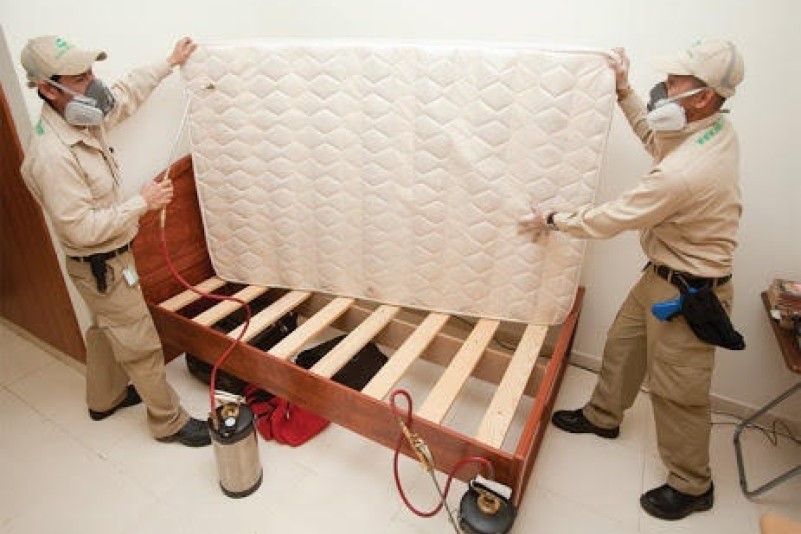Premier Bed Bug Exterminator: DC Exterminator for Effective Treatment
Wiki Article
Exploring the Science Behind Bed Insect Heat Treatments as a Lasting Pest Monitoring Strategy
In the realm of insect monitoring, the pursuit for reliable and lasting solutions continues to be a constant pursuit. One such technique that has actually obtained grip in recent years is making use of warmth therapies to combat bed bug invasions. By using the scientific research behind thermal fatality points for these persistent insects, warm treatments supply a promising option to conventional chemical-based techniques. The ins and outs of just how heat successfully removes bed insects and the more comprehensive effects for sustainable insect monitoring techniques make this a topic worth checking out better.Bed Bug Heat Treatment Process

Thermal Fatality Factor for Bed Bugs
Revealing bed insects to elevated temperatures past their thermal tolerance array is essential for accomplishing reliable eradication in warmth therapy processes. The thermal death factor for bed pests refers to the temperature level at which these bugs can not endure. Study shows that bed insects begin to perish when revealed to temperatures over 113 ° F(45 ° C) for a continual duration. As the temperature level enhances, so does the mortality rate of bed bugs. At around 118 ° F(48 ° C ), bed pests begin to pass away quickly, with a mortality price of almost 99% within minutes of direct exposure. This demonstrates the sensitivity of bed bugs to heats and highlights the performance of heat therapies in getting rid of infestations. By reaching and keeping temperature levels over the thermal death point for bed insects, pest monitoring specialists can guarantee detailed removal of bed bug populaces, including hard-to-reach locations where chemical therapies might be less efficient. Understanding the thermal death factor for bed insects is crucial for implementing successful warm therapy strategies and attaining lasting pest administration end results.Benefits of Heat Treatments
Having actually established the important thermal death factor for bed pests, it is essential to now check out the considerable advantages that warmth therapies use in properly removing these resistant parasites. One of the key benefits is that warmth can permeate deep into holes and splits where bed insects conceal, making sure that also the most hard-to-reach locations are warmed to lethal temperature levels.Furthermore, warm treatments are environmentally friendly and non-toxic, making them a sustainable parasite management method. Unlike chemical pesticides, warm therapies do not leave hazardous residues that can present threats to human wellness or the environment. This aspect is particularly essential in sensitive atmospheres such as healthcare facilities, institutions, and suburbs where chemical usage might not be preferable.
you can check here Furthermore, warm treatments have a high success rate in removing bed pest problems in a solitary therapy, minimizing the requirement for several sees and minimizing disruption to residents. This efficiency not just conserves time and cash however likewise offers comfort to those dealing with bed pest troubles.
Efficiency of Warm Treatment

Research study studies have actually regularly shown the effectiveness of warmth treatments in achieving a high price of bed insect mortality. Effectively carried out warmth treatments can get to all the fractures and holes where bed pests may be nurturing, guaranteeing a comprehensive technique to extermination. Heat therapies have the included advantage of killing bed insect eggs, which are often resistant to standard chemical treatments. In general, the effectiveness article source of warmth therapies in eliminating bed pest infestations makes them a trustworthy and sustainable parasite monitoring strategy.
Lasting Parasite Monitoring Benefits
Applying lasting parasite monitoring techniques uses long-lasting benefits for both the setting and public wellness. By using techniques such as warmth therapies for bug control, we can decrease the reliance on harmful chemical pesticides that can have damaging results on environments and human health and wellness - DC exterminator. Lasting bug management strategies aid in maintaining biodiversity by targeting particular pests without damaging non-target organisms, thereby preserving a balanced ecological community
In addition, sustainable parasite administration practices add to the overall wellness and health of the public. By decreasing exposure to poisonous chemicals utilized in traditional bug control methods, warm therapies give a much safer choice for insect monitoring in domestic, business, and public spaces. This decrease in chemical usage likewise helps in preventing pesticide deposits from contaminating dirt, water, and air, protecting environmental top quality.
Conclusion
Finally, bed pest heat treatments have actually been revealed to be a sustainable and efficient insect management method. The thermal fatality point for bed insects makes them prone to warmth treatments, which have various benefits over typical chemical treatments. The effectiveness of warmth treatments in getting rid of bed pest infestations while lessening ecological influence highlights the possibility of this method as a lasting solution for pest control.The bed insect warm therapy procedure entails elevating the temperature level within ravaged areas to a degree that properly removes bed pests and their eggs. By getting to and keeping temperature levels over the thermal fatality factor for bed pests, pest management professionals can guarantee extensive elimination of bed bug populations, including hard-to-reach locations where chemical therapies may be less effective. One of the key benefits is that heat can pass through deep right into crevices and splits where bed pests conceal, making sure that also the most hard-to-reach areas are heated to lethal temperature levels. Unlike chemical therapies that might leave behind immune populaces, warm treatments offer a eco pleasant and non-toxic remedy that can pass through deep right into furniture, walls, and various other hard-to-reach areas where bed bugs conceal.
The thermal fatality point for bed insects makes them vulnerable to heat therapies, which have many advantages over traditional chemical therapies.
Report this wiki page